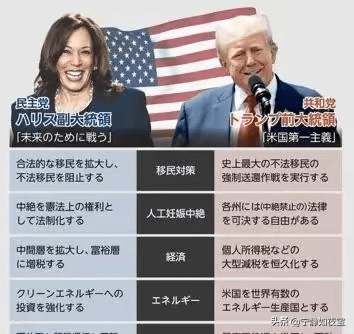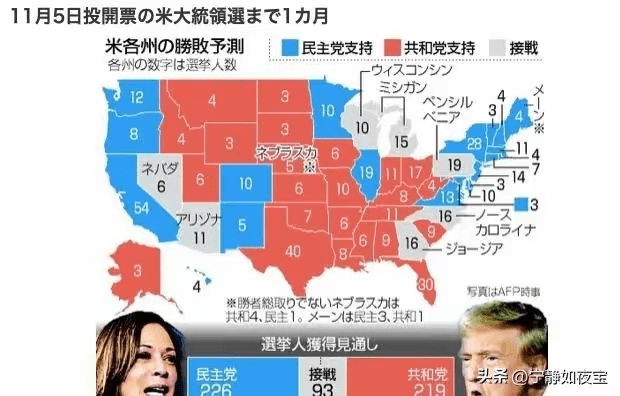There is only one month left before the US presidential election on November 5. According to poll statistics, the election situation of Democratic Party candidate Harris and Republican Party candidate Trump is very close. The number of voters in the state election supporting the Democratic Party is 226, while the number of voters in the state election supporting the Republican Party is 219. The number of voters in the state election where the situation is unclear is 93. Neither party has reached the majority of 270. However, judging from the number of temporary supporters, Trump did not take advantage of the temporary public sentiment caused by the assassination. Instead, Harris, who gave up the election after Biden, has the upper hand with a gap of 7 more voters.
#Battle of 270 votes: The final showdown between Harris and Trump, who will make a comeback?
The US presidential election voting day on November 5 has entered the final critical moment. According to the latest polls, the support rates of Democratic candidate Harris and Republican candidate Trump are almost the same, and the situation is extremely tense.
Although Harris's approval rating is slightly higher than Trump's, the gap between the two is only 7 states' electoral votes. More importantly, the election situation in 93 swing states with electoral votes is still unclear. This "battle of 270 votes" will determine who can get more than half of the electoral votes and become the new president of the United States.
Trump's Challenge: The Shadow of the Assassination
Trump originally expected to gain public sympathy and support through the highly publicized assassination. This political assassination that shocked the world took place in early October, and his opponent Biden immediately announced his withdrawal from the election. This unexpected incident seemed to have brought Trump an unexpected opportunity.
However, this is not the case. Poll data shows that this incident did not bring much practical benefit to Trump. On the contrary, Harris rose against the trend during this period and narrowed the gap with Trump.
"The assassination itself did attract strong attention, but it did not bring Trump a lasting advantage in public opinion," said Daniel Green, a senior analyst at a Washington think tank. "People are more concerned about the candidate's policy proposals and overall image."
Although Trump won some sympathetic votes in this incident, his negative image is deeply rooted and it is difficult to reverse it in a short period of time. Harris, on the other hand, has gradually won the trust of more voters with her gentle and steady image.
##Harris' counterattack: How to break the deadlock?
Harris's comeback is remarkable. After Biden withdrew, she quickly integrated the support within the Democratic Party and effectively resolved the differences within the party. At the same time, she also took the initiative to extend an olive branch to the Republican camp, trying to win more cross-party votes.
"Harris' strategy is very interesting," said Emily Jenkins, a political science professor at New York University. "She has neither completely abandoned the core ideas of the Democratic Party nor completely closed herself off. Instead, she has tried to find a balance between the two. This inclusive stance has won the approval of many voters."
In addition, Harris also made full use of social media to actively interact with voters and understand their demands. Her campaign team also continuously optimized campaign strategies and launched targeted policy proposals for different groups.
"Her campaign team did a great job," said Professor Jenkins. "They were good at capturing public opinion trends and adjusting their response strategies in a timely manner. This enabled Harris to narrow the gap with Trump in a short period of time."
Although Harris is still slightly behind, her momentum is clearly on the rise. If she can continue this momentum, she is expected to turn the tide at the last critical moment.
##Voter's Voice: Who are you voting for?
Ordinary voters have mixed views on this battle for 269 votes.
"I have always supported the Democratic Party, but it is difficult for me to make a choice this time," said Mary Jenkins, a voter from Pennsylvania. "Although Trump has a lot of controversy, he has done a good job on some economic policies. Although Harris has a good image, I don't quite agree with her policy stance."
Another voter from Florida, Jack Roberts, said: "I tend to support the Republican Party, but I might vote for Harris this time. Some of Trump's words and deeds during his tenure are really unacceptable. I think it would be better to change someone."
Although voters from different backgrounds have different political orientations, their evaluations of the two candidates are quite complex, which also reflects the subtlety and uncertainty of the current election situation.
Conclusion
This "270-vote battle" is confusing. Although Trump once took advantage of unexpected events to gain an advantage, he ultimately failed to convert it into lasting support. Harris, on the other hand, rose against the trend with a thoughtful campaign strategy and narrowed the gap with Trump.
Now, the election results have entered a white-hot stage. No matter who wins in the end, this fierce contest will undoubtedly have a profound impact on the American political landscape.
For ordinary voters, how to weigh the pros and cons of the two candidates and make a rational choice has become a major challenge at present. In this "battle of 270 votes", every vote is crucial.






